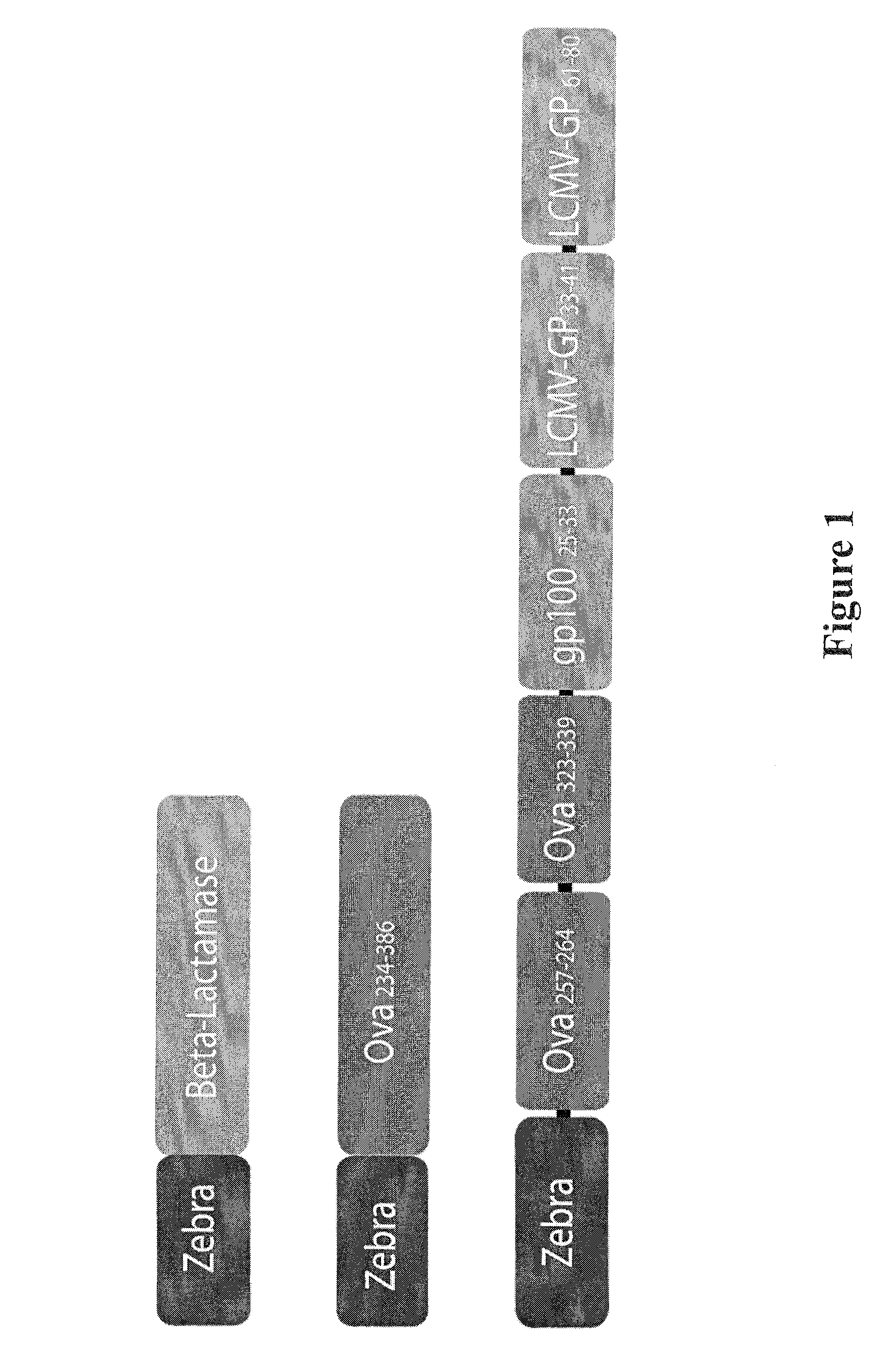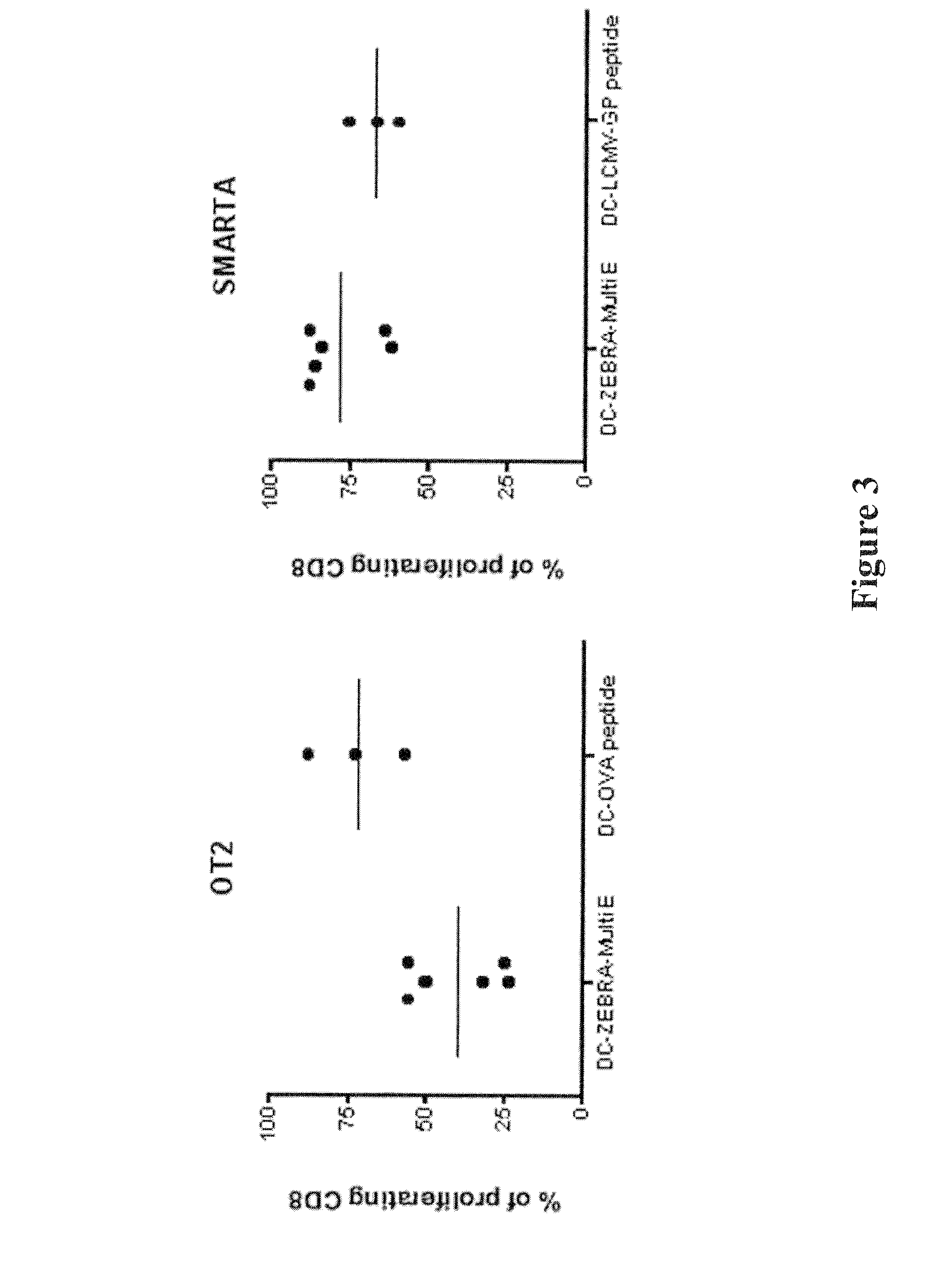Multi-epitopic vaccine
a vaccine and epitope technology, applied in the field of multiepitope vaccines, can solve the problems of limited protein uptake by apcs, limited clinical success of these approaches, and several limitations
- Summary
- Abstract
- Description
- Claims
- Application Information
AI Technical Summary
Benefits of technology
Problems solved by technology
Method used
Image
Examples
example 1
ZEBRA-Fusion Proteins Constructs
[0160]Three different constructs (FIG. 1) were engineered and cloned in a modified pET-15b vector deleted for thrombin and stop codons. N-terminal fusion proteins comprising amino acids residues 178-220 of ZEBRA (NCBI Accession Number YP—401673) were made carrying His-Tag allowing protein purification. The amino acid sequence of the ZEBRA fragment comprised in the ZEBRA fusion proteins described in the examples is SEQ ID NO: 8.
[0161]Construct 1: ZEBRA-β-lactamase: encodes β-lactamase from E. Coli deleted for the secretion signal (residues 1-23) and residue 24 His was changed to Asp to create an optimal Kozak sequence.
[0162]Construct 2: ZEBRA-OVA: encodes a truncated form of the chicken ovalbumin (OVA234-386). This construction contains both CD8 epitope OVA257-264 and CD4 epitope OVA323-339.
[0163]Construct 3: ZEBRA-MultiE: encodes a chimeric protein with three CD8 epitopes from the ovalbumin OVA257-264, from lymphocytic choriomengitis virus glycoprotei...
example 2
Protein Loading into DCs
[0164]A standard and reproducible protein delivery protocol for DCs was established using the quantifiable reporter protein β-lactamase and CCF2-AM its membrane-permeable substrate that allows monitoring of free cytoplasmic protein. Indeed, CCF2-AM is a lipophilic and esterified substrate, which can enter into the cells. Endogenous cytoplasmic esterase rapidly converts CCF2-AM into a negatively charged form (CCF2), which is not able to cross cell membranes, including endosomal membranes. Therefore, the β-lactamase transduced into cells with ZEBRA (construct 1) can cleave the CCF2 that is free in the cytoplasm.
[0165]A direct correlation between the protein concentration and time of incubation was observed. With increasing time and protein concentration, higher transduction efficiencies up to 70% were observed. For all the experiments described below a protein concentration of 0.3 μM and a loading time of 4 h were used, reaching transduction efficiencies of 70%...
example 3
MHC Class I Restricted Presentation after ZEBRA-OVA Fusion Protein Loading into DCs
[0166]Functional MHC I restricted presentation by DCs after loading with a truncated ovalbumin (OVA) protein (amino acids 234-386) fused to the PTDs (construct 2) was verified. Presentation of the immunodominant CD8+ epitope from ovalbumin (SIINFEKL, OVA257-264) was detected with the specific T cells from OT-1 T cell receptor (TCR) transgenic mice in vitro. TCR transgenic mice have all the CD8+ or CD4+ T cells specific for one epitope. The CD8+ TCR transgenic mice used here are OT-1, specific for the OVA257-264 epitope.
[0167]Bone marrow derived dendritic cells (BMDCs) were loaded with ZEBRA-OVA257-264 during 4 h, washed and matured overnight with maturation cocktail containing IFNα, IFNγ, IL-4 and PolyIC (Fujita et al., 2009, Cancer Res. 69:1587-1595). OT-1 cells were stained with the non-toxic dye carboxyfluorescein succinimidyl ester (CFSE). Cell proliferation results in dilution of CFSE, which can ...
PUM
| Property | Measurement | Unit |
|---|---|---|
| Fraction | aaaaa | aaaaa |
| Fraction | aaaaa | aaaaa |
| Fraction | aaaaa | aaaaa |
Abstract
Description
Claims
Application Information
 Login to View More
Login to View More - R&D
- Intellectual Property
- Life Sciences
- Materials
- Tech Scout
- Unparalleled Data Quality
- Higher Quality Content
- 60% Fewer Hallucinations
Browse by: Latest US Patents, China's latest patents, Technical Efficacy Thesaurus, Application Domain, Technology Topic, Popular Technical Reports.
© 2025 PatSnap. All rights reserved.Legal|Privacy policy|Modern Slavery Act Transparency Statement|Sitemap|About US| Contact US: help@patsnap.com



